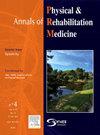Virtual reality effects on balance and mobility in people with Parkinson's disease: A systematic review with meta-analysis
IF 4.6
3区 医学
Q1 REHABILITATION
Annals of Physical and Rehabilitation Medicine
Pub Date : 2025-04-19
DOI:10.1016/j.rehab.2025.101967
引用次数: 0
Abstract
Background
Specific Virtual Reality (VR) systems designed for rehabilitation and non-specific VR systems intended for entertainment are used in Parkinson's disease (PD) rehabilitation, but their effects are unclear. The extent to which these systems integrate neurorehabilitation principles for PD rehabilitation is unknown. Previous meta-analyses exist but data are lacking on the impact of VR on mobility.
Objectives
Primary aim: to perform a systematic review with meta-analysis comparing the effects of VR and conventional therapy (CT) on balance and mobility in people with PD. Secondary aim: to perform subgroup analyses on VR type, disease severity, and treatment duration.
Methods
Randomized controlled trials comparing VR and CT effects on balance and mobility in adults with PD were selected from Pubmed and EMBASE until September 2024. Data were synthesized qualitatively and quantitatively using a standardized mean difference (SMD) with random-effects model. Subgroup analyses (VR type, disease severity, and treatment duration) and analysis of fulfilled neurorehabilitation principles were conducted. Risk of bias was assessed (PEDro checklist and Cochrane RoB-2).
Results
Twenty-eight studies (12 countries) were included: 1151 participants, mean Hoehn & Yahr stage between 1.4 and 3.4, mean (SD) treatment duration 18.8 (11.5) hours in the qualitative analysis and 23 in the quantitative analysis. Overall risk of bias was high (10 studies), some concerns (13 studies), or low (5 studies). VR was more effective than CT for balance (630 participants; 11 studies; SMD 0.42; 95% CI, 0.19–0.65; P < 0.001) and as effective as CT for mobility (591 participants; 10 studies; SMD 0.18; 95% CI, -0.03 to 0.40; P = 0.09). Balance and mobility outcomes did not differ between specific and non-specific VR. Subgroup analyses found no significant differences.
Conclusions
VR improved balance in people with PD more than CT (low-certainty evidence). VR improved mobility similarly to CT (moderate-certainty evidence). VR games should integrate neurorehabilitation principles.
虚拟现实对帕金森病患者平衡和活动能力的影响:荟萃分析的系统综述
专为康复设计的特定虚拟现实(VR)系统和用于娱乐的非特定虚拟现实系统用于帕金森病(PD)康复,但其效果尚不清楚。这些系统在多大程度上整合PD康复的神经康复原理是未知的。先前的荟萃分析存在,但缺乏VR对移动性影响的数据。主要目的:通过荟萃分析对VR和常规治疗(CT)对PD患者平衡和活动能力的影响进行系统评价。次要目的:对VR类型、疾病严重程度和治疗时间进行亚组分析。方法从Pubmed和EMBASE中选择2024年9月之前比较VR和CT对成年PD患者平衡和活动能力影响的随机对照试验。采用随机效应模型的标准化平均差(SMD)对数据进行定性和定量综合。进行亚组分析(虚拟现实类型、疾病严重程度、治疗时间)和完成神经康复原则分析。采用PEDro检查表和Cochrane rob2评估偏倚风险。结果纳入28项研究(12个国家):1151名受试者,平均为Hoehn &;Yahr分期在1.4 ~ 3.4之间,定性分析平均(SD)治疗时间18.8(11.5)小时,定量分析平均(SD)治疗时间23小时。总体偏倚风险为高(10项研究)、部分关注(13项研究)或低(5项研究)。VR在平衡方面比CT更有效(630名参与者;11研究;SMD 0.42;95% ci, 0.19-0.65;P & lt;0.001),在活动能力方面与CT一样有效(591名参与者;10的研究;SMD 0.18;95% CI, -0.03 ~ 0.40;P = 0.09)。特异性和非特异性VR之间的平衡和活动结果没有差异。亚组分析未发现显著差异。结论svr比CT更能改善PD患者的平衡(低确定性证据)。与CT类似,VR改善了活动能力(中等确定性证据)。VR游戏应该融入神经康复原理。
本文章由计算机程序翻译,如有差异,请以英文原文为准。
求助全文
约1分钟内获得全文
求助全文
来源期刊

Annals of Physical and Rehabilitation Medicine
Medicine-Rehabilitation
CiteScore
7.80
自引率
4.30%
发文量
136
审稿时长
34 days
期刊介绍:
Annals of Physical and Rehabilitation Medicine covers all areas of Rehabilitation and Physical Medicine; such as: methods of evaluation of motor, sensory, cognitive and visceral impairments; acute and chronic musculoskeletal disorders and pain; disabilities in adult and children ; processes of rehabilitation in orthopaedic, rhumatological, neurological, cardiovascular, pulmonary and urological diseases.
 求助内容:
求助内容: 应助结果提醒方式:
应助结果提醒方式:


